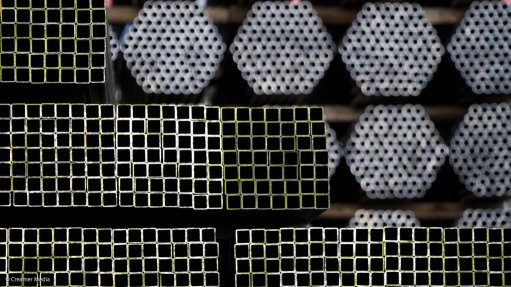Digital tools unlock manufacturing excellence
This article has been supplied and will be available for a limited time only on this website.
South Africa’s manufacturing sector is moving quickly in adopting AI-powered, digital automation tools to enhance efficiency, product precision and workforce optimisation. Fatima Khota, business unit manager in Rectron’s Point-of-Sale Division looks at the economy’s journey to automated factories, as Rectron hosts its first annual ‘Technology in Manufacturing Conference’ in Cape Town in partnership with Zebra Technologies.
The manufacturing sector contributes around 13% of South Africa’s gross domestic product and is forecastto grow at an average rate of 5,7% per year over the next decade.
Statistics South Africa defines manufacturing (based on the Standard Industrial Classification of all Economic Activities) as a group of economic activities that involves production through industrial process.
This involves the physical or chemical transformation of materials, substances, or components into new products and includes various steps, like assembling parts and components of manufactured products.
Even today, much of South African manufacturing is still managed manually, with factory owners often relying on analogue “pen-and-clipboard” processes to document the comings and goings of raw materials, parts, equipment, personnel and finished products.
While this works for many, this speaks less to the effectiveness of these systems, but more to the resilience of the businesses, their products and their value to the economy.
Imagine how much better these factories would perform, how much more profitable they could be, and how much happier their people would be through full digital operations.
A 2022 University of Johannesburg study found that about 50% of large firms, 46% of medium-sized and 47% of small ones were still manually operated, with some semi-automation. Around 40% (large), 38% (medium) and 46% (small) were automated and ICT enabled, while 10%, 16% and 7% respectively were digital system enabled.
According to a 2019 PwC report, digitisation is set to completely transform the manufacturing industry, firstly by dissolving barriers between functions within operations, then connecting with the outside world in a seamlessly integrated, low-friction environment.
Out of 1155 manufacturing executives in 26 countries, 30% described their supply chains as using isolated solutions and optimising only on individual processes.A further 35% said their internal functions were integrated and collaborate closely, while 18% said they were digitally connected with external partners, integrating platforms for collaborations.
Only 9% of executives could claim “near-real-time end-to-end” integration and planning platforms across external networks. In most cases, this full-scale integration was due to these companies having what the report calls “digital champions”. These digital champions are executives with enough foresight, clout and resources to make key technology investments, track their effectiveness and ensure consistent software upgrades and training of personnel.
Technology unlocks efficiencies
For a manufacturing operation that has run successfully for decades, it is often hard to imagine what true digitisations looks like. Modern manufacturers are increasingly using data-driven processing and automation, not just for efficiency, but also to continuously eke out improvements in production excellence and precision, reduce waste and limit product variance, which is key to sustainable customer satisfaction.
In its Manufacturing Vision Study, Zebra Technologies noted that 92% of manufacturers felt that digital transformation is a strategic priority for their organisations, once its potential was recognised. Around 89% felt that digitisation projects are time, cost and labour-intensive upfront (with a long window to realise ROI), but 90% agreed that current and future market conditions were accelerating the need for digitisation.
In its study, UJ pointed to a lack of capital and digital infrastructure as the main factors that inhibit the adoption of digital technologies. On the other hand, human capital, international partnerships, exportation, and innovation enhance the adoption of digital technologies. This means that by making smart investments into smart infrastructure; while also training workers and partnering with world-class technology providers, they can unlock long-term value.
Transitioning to automation
By streamlining workflows and processes, training personnel and more accurately tracking assets, factories can enhance overall visibility and support workforces for optimised quality.
From the very start, in a factory’s receiving bay, raw materials can be verified and labelled using connected hand-held devices and printers.
Automation of lineside parts storage facilities can then enhance production efficiency by ensuring materials are delivered precisely when needed, preventing interruptions and maintaining smooth operations.
When parts arrive in the components manufacturing floor, they are 3D-vision scanned and inspected for defects, while monitoring systems adjust production and staffing schedules proactively, based on early insights into inventory and demand from suppliers. This is further supported by enhanced communication systems to boost collaboration across the plant through improved remote support solutions and consolidated devices, reducing unnecessary foot traffic.
By the time a product arrives in quality control, it has been scanned for correct assembly and quality standards, so that when it is packaged, it is recorded for final integrity and adherence to supplier service level agreements before dispatching. In the background, predictive maintenance systems use connected sensors and smart machines to monitor equipment health, forecast potential failures, and generate real-time insights to proactive, cost-effective maintenance.
While we are still quite far from seeing fully automated factories run by robots – like Chinas’ emerging “dark factories” (no personnel means no need to even spend on lighting bills) – South Africa still needs to come to grips with the basics of connected factories. By making strategic investments using integrated solutions from technology providers like Zebra, business can from already locally successful operations to world-class entities that can compete anywhere in the world’s export markets.
Comments
Announcements
What's On
Subscribe to improve your user experience...
Option 1 (equivalent of R125 a month):
Receive a weekly copy of Creamer Media's Engineering News & Mining Weekly magazine
(print copy for those in South Africa and e-magazine for those outside of South Africa)
Receive daily email newsletters
Access to full search results
Access archive of magazine back copies
Access to Projects in Progress
Access to ONE Research Report of your choice in PDF format
Option 2 (equivalent of R375 a month):
All benefits from Option 1
PLUS
Access to Creamer Media's Research Channel Africa for ALL Research Reports, in PDF format, on various industrial and mining sectors
including Electricity; Water; Energy Transition; Hydrogen; Roads, Rail and Ports; Coal; Gold; Platinum; Battery Metals; etc.
Already a subscriber?
Forgotten your password?
Receive weekly copy of Creamer Media's Engineering News & Mining Weekly magazine (print copy for those in South Africa and e-magazine for those outside of South Africa)
➕
Recieve daily email newsletters
➕
Access to full search results
➕
Access archive of magazine back copies
➕
Access to Projects in Progress
➕
Access to ONE Research Report of your choice in PDF format
RESEARCH CHANNEL AFRICA
R4500 (equivalent of R375 a month)
SUBSCRIBEAll benefits from Option 1
➕
Access to Creamer Media's Research Channel Africa for ALL Research Reports on various industrial and mining sectors, in PDF format, including on:
Electricity
➕
Water
➕
Energy Transition
➕
Hydrogen
➕
Roads, Rail and Ports
➕
Coal
➕
Gold
➕
Platinum
➕
Battery Metals
➕
etc.
Receive all benefits from Option 1 or Option 2 delivered to numerous people at your company
➕
Multiple User names and Passwords for simultaneous log-ins
➕
Intranet integration access to all in your organisation


















